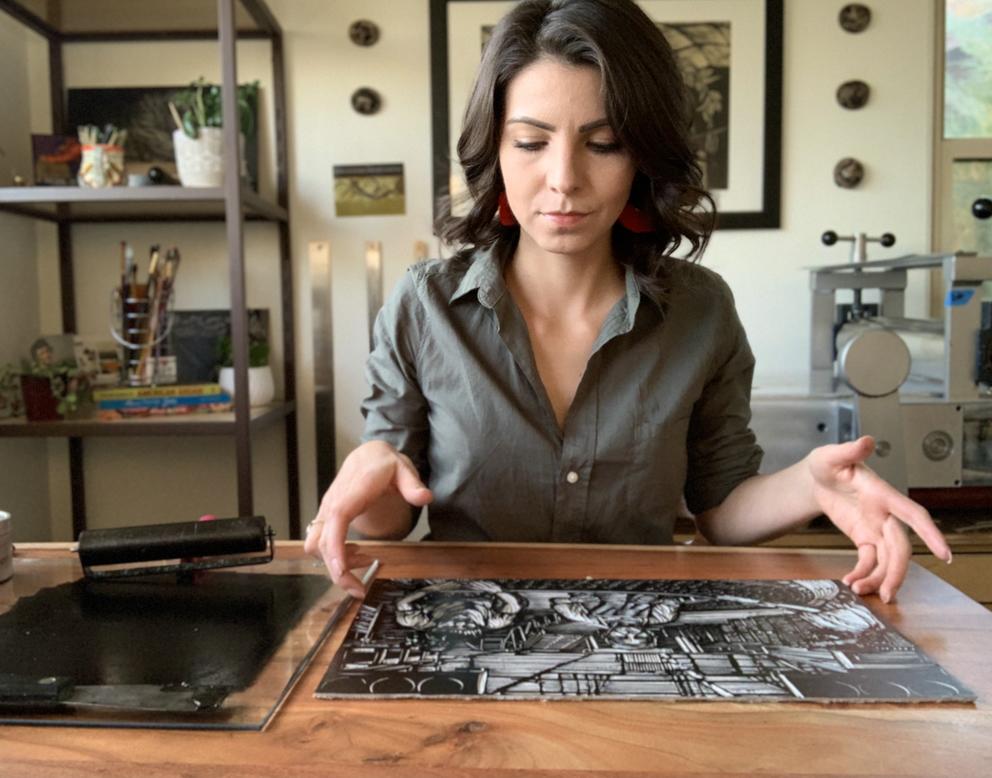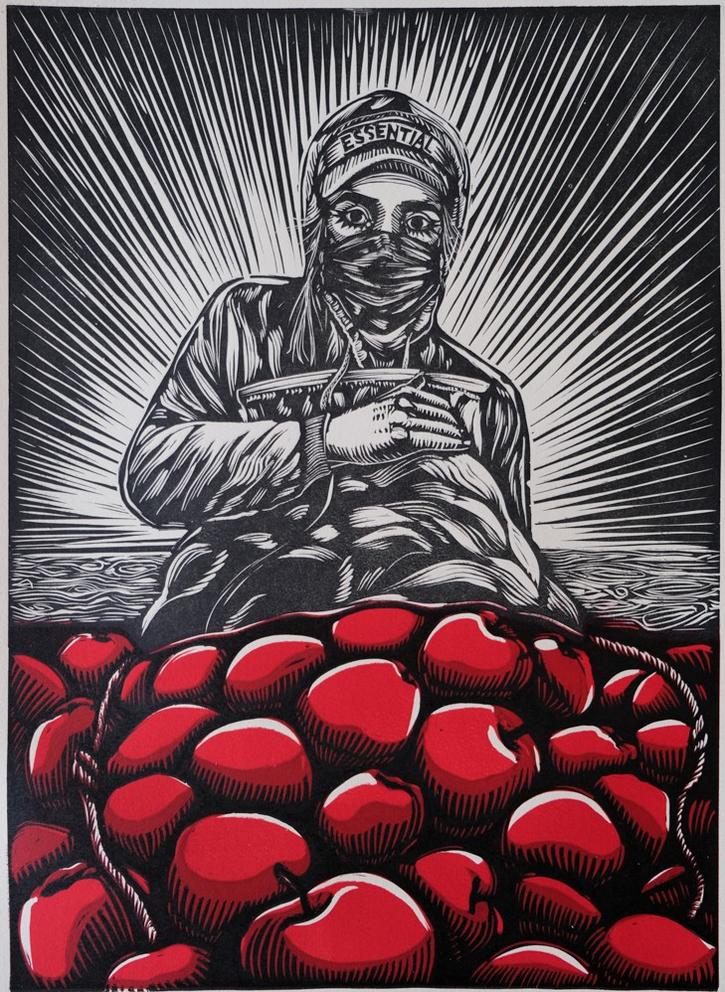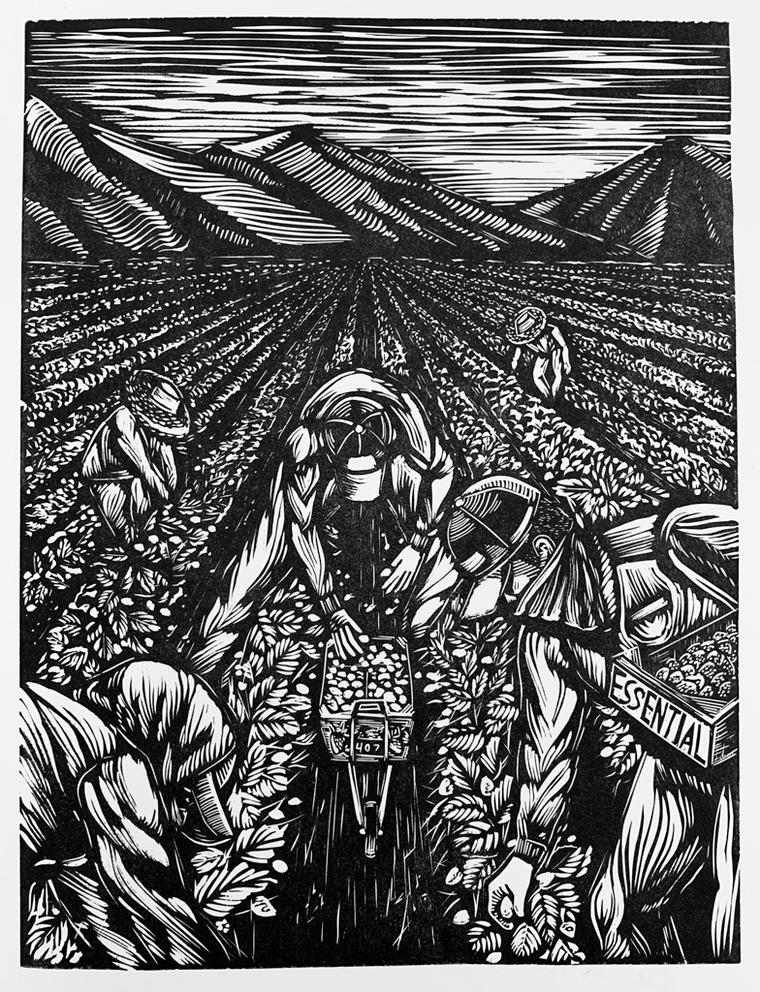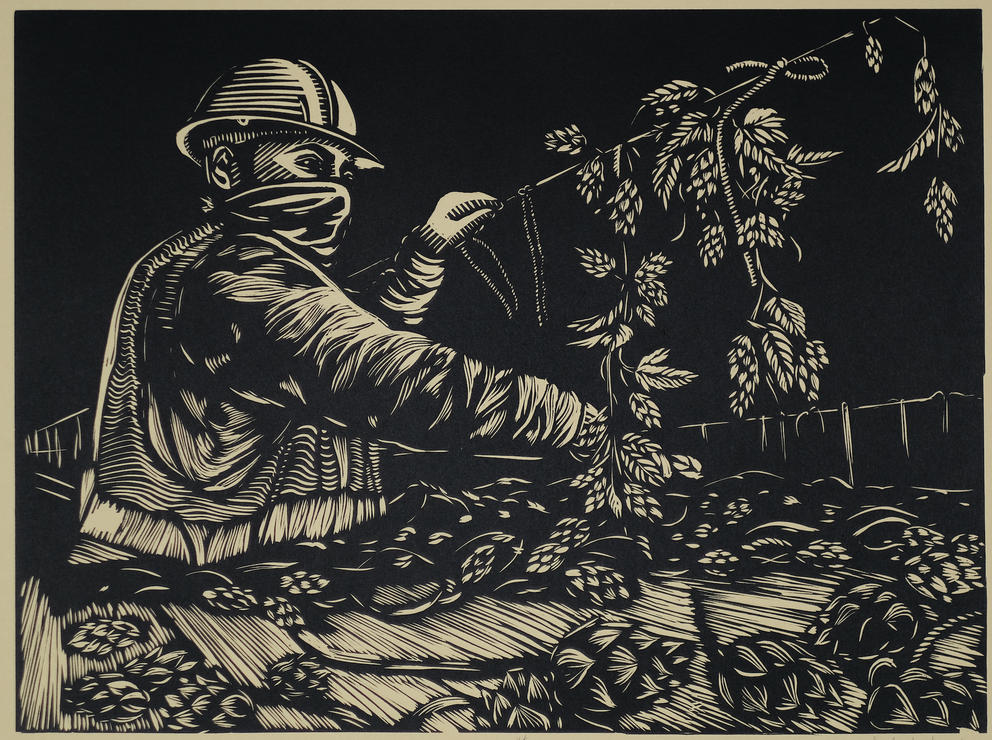An artist and art teacher, Tirado is based in the “nation’s fruit basket,” where 50% of the population identifies as Latino or Hispanic and agricultural jobs account for more than a quarter of the region’s economy. Her linoleum block relief prints honor the people who harvest the produce many of us buy without much thought as to its origins.
Her series America’s Essential Workers (recently on view at Davidson Galleries) illustrates the arduous field work many Latinos withstand. Tirado, 30, says she dedicated the series to farmworkers “to appreciate and celebrate what they do for our valley, for our nation's economy and what they contribute to our community as well.”
In one image, a masked worker holds a basket overflowing with red apples. In another, workers hunch over produce in a field surrounded by mountains. Most of the prints are created in the black-and-white style that traces back to Tirado’s Mexican heritage.
Tirado is heavily influenced by the graphic print tradition that originated in early 20th century Mexico, when artists carved wood or linoleum blocks to share political messages via easily reproducible prints. In her own work, Tirado uses the same method to bring laborers to life, with detailed clothing textures or shadows on their faces as they pull in hops, berries and apples.
She has also used printmaking techniques to reenvision Lotería cards that reflect both her Pacific Northwest and Mexican American identity. “El Salmón” features a high-contrast sockeye, twisting and floating on a bold background. Another recent image, depicting a gloved teen working on a factory line, illustrated a ProPublica story concerning the large number of undocumented children working in suburban factories. This year, Seattle Print Arts awarded Tirado the prestigious Larry Sommers Fellowship, with which she intends to focus on illuminating the apple industry.
Like her artistic predecessors, Tirado uses her prints to share the stories of unsung workers. But she sees her role as an art teacher equally as vital.
Having graduated from the University of Washington in 2013 with a degree in interdisciplinary visual arts, Tirado now teaches at Union Gap School, a K-8 school in the Yakima Valley with fewer than 700 students, the majority of whom (80%) identify as Latino or Hispanic. By contrast, nearly 98% of teachers at the school identify as white. Tirado is the exception. As one of very few Mexican American teachers, she feels the same urgent need for Latino representation that guides her work as an artist.
Crosscut spoke with Tirado about the concept of a “Latino monolith” and the importance of highlighting some of the country’s most undervalued essential workers.
This interview has been edited for length and clarity.
What were you doing when the pandemic began?
In my teaching life, we were learning about the history of sumi-e painting, a Japanese style like calligraphy going back to China. Then the pandemic hit. I had purchased calligraphy brushes for all my students and they were creating cherry blossom tree branches. I remember walking into my classroom the Monday after they shut everything down, and there were the trays on the table with the ink and their paintings still in the drying rack.
What’s it like to be an art teacher during a pandemic?
A lot of my kids go from babysitter to grandma's house, to tia’s house, to uncle’s house. They forget their materials or they lose their materials or they simply don't have materials. I’ve been putting together art kits for them and distributing them to families, so they actually have materials they can use. It's a challenge, especially with students not having devices to begin with. But for those students that have been able to log on, it's refreshing to be able to see them, even if it's virtually. They miss learning from one another, talking to each other about their work and creating together. I really miss seeing them. Being a teacher taught me how to be an advocate for my students, my program, the arts and my community. The prints that I create are just an extension of that.
You grew up in Western Washington. How did you land in Yakima?
I grew up in Seattle and Tacoma. That's home. I moved out here to go to grad school. Initially when I moved out to Yakima, I had the intention of moving back [but] the longer I lived here the more I was like, “I need to stay here. I feel like I have some work to do here. There's a reason why I'm here, and I think I'm needed here.”
How did you feel you were needed?
I'm one of two Latina teachers at my school. My kids are 80% Latino, Hispanic. I really connected with my students. When I went to school, I didn't have a teacher that looked like me, that I made a connection with on a cultural level. I know a lot of these students are probably not going to have that. I’m working with pretty much who I was as a kid, so I decided to stay here for that.
Identity is a big theme in your work, so how do you identify?
It has been a little complex. I've always identified as Latina, mainly Mexican American. And Latinx for me is fine, too. I'm comfortable using Latinx when I'm talking about my students, a new generation. So Mexican American, Latinx, I can go both ways.
The elections stirred up lots of opinions about the Latinx diaspora. Why do you think it’s hard for people to understand that Latinos are not a monolith?
So many articles have been published on “the Latino vote.” [But] there's all kinds of Latinos ... Mexicans, Salvadorians, Cubans, Venezuelans. You have all of these different people with different histories and different backgrounds, with different ideas, different ideologies. When you just group all of them in one, of course a lot of results are not going to make sense. I think there's a lot of work that needs to be done with unpacking just the word Latino itself.
How is your art connected to your identity?
I'm very proud of my background. I'm very proud of my heritage, of my roots and being Mexican and Mexican American. And my mother and father's history and reasons for coming to this country. That connection with my culture is illustrated in a lot of these pieces.
Usually, before I start working, I always have this thought in my head of like, “Why is this important? Why am I creating this?” It comes down to what I value and what's important to me. It's not just because COVID hit that I created America's Essential Workers. These workers have always been essential.
How did you begin printmaking?
My junior year of college I stumbled upon the printmaking room at the University of Washington. I ended up changing my major because the printmaking department and professors were phenomenal. I started with relief printing, woodblock printing and linoleum, which I’m still doing. I always loved [turn-of-the-century Mexican political lithographer] Jose Guadalupe Posada’s prints … so I gravitated even more towards printing. Printing has been historically used by marginalized communities as a tool to voice the social and political injustices in Mexico. So for me this is what printing is. It's a vehicle to socially empower [people].
Tell me more about your series America’s Essential Workers. Who are those workers and why do you think it’s important to highlight them?
I've been working on this series since 2017. I've been highlighting different perspectives of the labor conducted by Mexican farmworkers here in the Yakima Valley since I started interacting with and being a part of the community — not to mention being a public servant and working with these kids whose parents do the work — there's an automatic connection. I wanted to learn more about their home life, where these kids come from, their background and their families. I really wanted to honor this demographic of people who work in the fields. Oftentimes they are underrepresented and underrecognized for their work. When the pandemic hit, it just shed more light on these essential workers and how valuable they are to our society and to our nation's economy.
You received the 2020 Larry Sommers Fellowship from Seattle Print Arts. Tell me about what you are doing with that fellowship.
I wanted to narrow in on the apple industry in the valley … further explore the production and harvesting. I have the connections to be able to go on these farms safely and talk to some of these workers. Apple harvest has a window of time. It's not year-round. So I wanted to get on the field to shed light on the process, their hard work, and have pieces my students can relate to — something that's representative of the demographic of people here, of the type of work that is done and a celebration. My hope was to visit more farms, but due to COVID, many companies were not allowing people to visit and interact with workers. I was able to capture many images of the harvest, and my hope is to create several new pieces as a result from my field experiences.
What’s your take on how farmworkers have been treated during the pandemic?
I think about the strikes that were happening in May. They weren't receiving hazard pay or sick pay. They were advocating for safer working conditions. There were about seven fruit-packing facilities where farm workers walked out. There was an inadequate, slow response from the state for how to protect these workers. I've also been to companies where they took precautions right off the bat, and they equipped their workers with the proper care that they needed, the PPE [personal protective equipment], hand-washing stations and proper distance. It depends on the warehouse or company.
Has the pandemic shifted the importance people place on art and culture?
I think so. Now, there's a lot more focus on the arts, like, “I want to listen to a new type of music” or “I want to read a new book.” I'm not a dancer, but I do put on YouTube videos and practice my salsa footwork. Right now is the time when artists are needed, our creations are needed in the world. What would the world be without the arts? Boring.
How do you imagine the art scene will come out the other end of this pandemic?
The art scene is going to be more intentional with who they are displaying in galleries and what these artists are creating, expressing and representing. I say that because I've been working with pushing some of those boundaries within Yakima, questioning who gets to decide what will go in these institutions and gallery spaces, and getting people thinking, “Is it reflective of these places, of the valley itself?”
Get the latest in local arts and culture
This weekly newsletter brings arts news and cultural events straight to your inbox.










